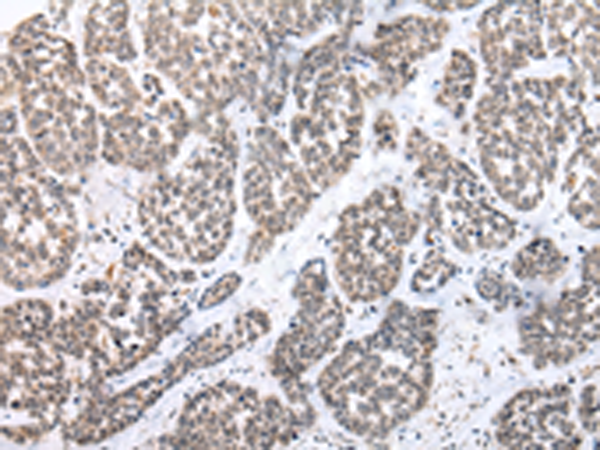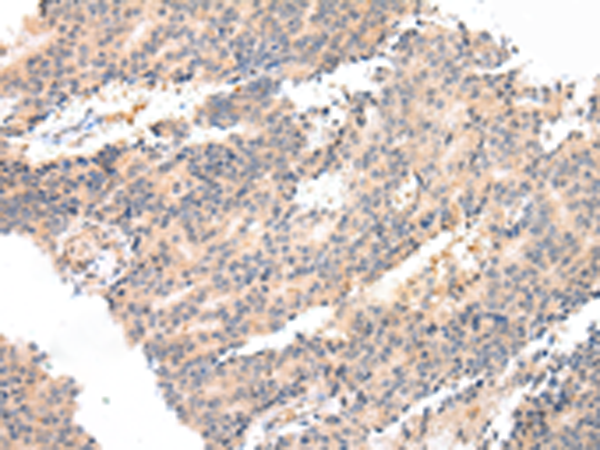

| WB | 咨询技术 | Human,Mouse,Rat |
| IF | 咨询技术 | Human,Mouse,Rat |
| IHC | 1/25-1/100 | Human,Mouse,Rat |
| ICC | 技术咨询 | Human,Mouse,Rat |
| FCM | 咨询技术 | Human,Mouse,Rat |
| Elisa | 1/2000-1/5000 | Human,Mouse,Rat |
| Aliases | EP3; EP3e; EP3-I; EP3-II; EP3-IV; PGE2-R; EP3-III |
| Host/Isotype | Rabbit IgG |
| Antibody Type | Primary antibody |
| Storage | Store at 4°C short term. Aliquot and store at -20°C long term. Avoid freeze/thaw cycles. |
| Species Reactivity | Human |
| Immunogen | Synthetic peptide of human PTGER3 |
| Formulation | Purified antibody in PBS with 0.05% sodium azide and 50% glycerol. |
+ +
以下是关于PTGER3抗体的3篇参考文献及其简要摘要:
---
1. **文献名称**: *Prostaglandin E receptor EP3 subtype mediates vascular contraction via G protein-mediated signaling*
**作者**: Sugimoto Y, et al.
**摘要**: 该研究开发了针对EP3受体(PTGER3)亚型的特异性抗体,并验证了其在血管平滑肌中的表达。抗体通过免疫组化和Western blot证实了EP3亚型在调节血管收缩中的功能,揭示了其通过G蛋白信号通路介导的机制。
---
2. **文献名称**: *EP3 receptor-associated protein interactions in colorectal cancer progression*
**作者**: Yang L, et al.
**摘要**: 研究利用抗PTGER3抗体分析结直肠癌组织中EP3受体的表达水平,发现其高表达与肿瘤侵袭性相关。抗体通过免疫荧光和流式细胞术验证,揭示了EP3与下游β-catenin通路的相互作用。
---
3. **文献名称**: *Characterization of a novel monoclonal antibody against human EP3 receptor for functional studies*
**作者**: Kobayashi T, et al.
**摘要**: 该文献报道了一种新型抗人EP3受体的单克隆抗体的开发与验证。通过ELISA和免疫沉淀实验证明其高特异性,并用于研究EP3在神经炎症模型中的激活机制,证实其作为研究工具的可靠性。
---
如需更详细文献信息(如期刊、年份),可进一步补充关键词或领域方向。
The PTGER3 antibody targets the prostaglandin E receptor 3 (PTGER3 or EP3), a G protein-coupled receptor that binds prostaglandin E2 (PGE2), a lipid mediator involved in inflammation, pain, and various physiological processes. PTGER3 is encoded by the *PTGER3* gene and exists as multiple splice variants, enabling diverse signaling pathways (e.g., Gi, Gs, or Gq coupling) depending on tissue context. It plays roles in regulating vascular tone, immune responses, and gastrointestinal functions, and has been implicated in pathological conditions such as cancer, cardiovascular diseases, and chronic inflammation.
PTGER3 antibodies are essential tools for research, enabling detection and localization of the receptor in cells and tissues via techniques like Western blotting, immunohistochemistry, or flow cytometry. They help elucidate PTGER3's expression patterns, signaling mechanisms, and interactions in disease models. Therapeutic applications are explored in preclinical studies, particularly in targeting PTGER3 to modulate PGE2-mediated pathways in cancer progression or inflammatory disorders. However, challenges remain in developing isoform-specific antibodies due to the receptor's splice variant complexity. Current research focuses on clarifying PTGER3's dual pro- and anti-inflammatory roles and its potential as a biomarker or drug target.
×